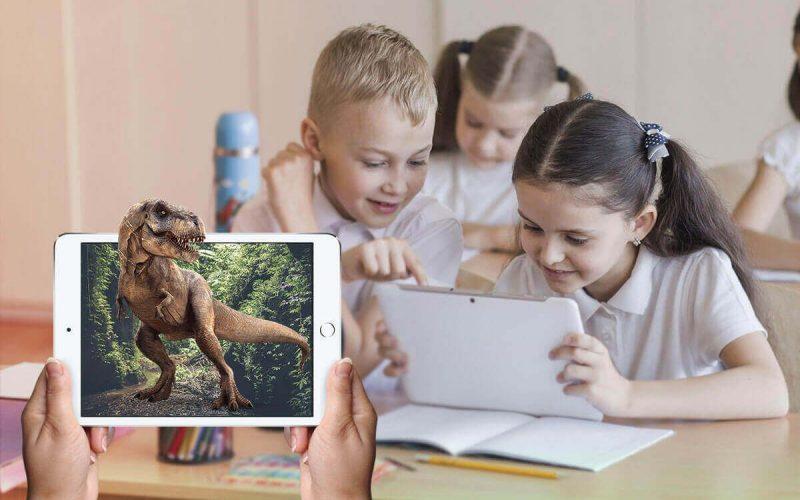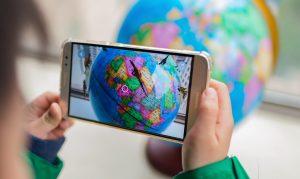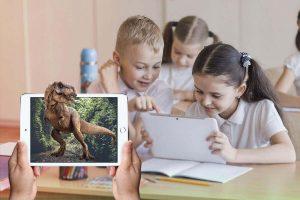
AR technology is accelerating several industries, and education is among the biggest beneficiaries of this advancement. This tech empowers both teachers and students as it’s helping the institutes transform the traditional teaching approach into an interactive experience.
From simplifying a complex STEM topic to giving a broader thinking perspective — AR in the classroom is establishing a better learning ecosystem. AR technology is new, but it has gained massive traction in a recent couple of years.
Regardless of the learning institute’s size, AR can help individuals lay a more robust learning foundation that allows students to cultivate their thinking ability. AR in schools and universities is empowering several fruitful advantages that help improve learners’ overall growth. Some of the critical disruptive benefits of augmented reality in education are:
Interactive Learning Materials
The most significant advantage of leveraging AR apps in learning is the highly interactive learning opportunity. AR technology can turn any complex figures into information-driven learning materials that students can understand better. In addition, the overall gamified experience of using AR keeps students engaged, and it leads to more productive classroom discussion.
Better Collaboration
Instructors often face the challenge of bringing all students on the same collaborative level while discussing a topic. It happens because every student has a unique way of perceiving the information. However, with an augmented experience, it becomes much easier for instructors to bring all students on a similar collaborative level.
Also, AR can help teachers to build interactive teams among students and encourage them for self-initiated learning.
Effective Learning Process
AR works as an accelerator to improve and boost the overall learning process. For example, students can learn better if they can see the graphics in action compared to text and visual representations.
It becomes easier for learners to understand complex information with AR to access anytime using their smart devices.
More Insightful Exploration

With augmented reality education apps, both teachers and students can have an insightful exploration of new topics and technology trends. Teachers get the opportunity to walk students through the subject with insights that are often difficult to understand from conventional learning methods. Apart from theoretical learnings, educators can uplift the practical sessions by presenting information more realistically.
A Safer Training Environment
Compared to the conventional training for students, AR is a much safer option to conduct such sessions. AR is a boon for the medical industry where students can first understand every minute functionality of the human body before beginning the training. It creates a safer environment that allows students to understand and operate better.
Undoubtedly, AR application in education is booming, and there are several productive use cases of this advancement. However, there are still some AR challenges that we all should know in advance.
Proper Training
AR is easier to use, but not every teacher can use it efficiently. In addition, there is a learning curve present in this technology that depends on how fast an instructor can learn its basics. In some cases, teachers might need to undergo basic operational training to get used to this technology.
Hardware Dependency
For achieving the best AR experience, schools, universities, and students must have the appropriate device to enjoy the high-end graphical projections. In the case of older devices, individuals may face quality-based issues while exploring the content. However, with advanced technologies like WebAR, this problem will become history soon.
A Long Way to Go
An AR education app is somewhat limited to the information compared to a traditional textbook or other digital resources. To mainstream this technology, we need to have a comprehensive replacement of the conventional resources. But, that time is not very far when students and teachers can carry the complete syllabus on their smartphones and tablet computers.
How AR in Education Works & Use Cases

The working of augmented reality is straightforward and exciting. In this technology, the smartphone’s camera scans the real-world surface and then projects the pre-made 3d graphics on that particular area. Once the projection is visible, individuals can have a 360° exploration of that design.
AR enhances the real-world environment with interactive text, graphics, and even sound effects for an interactive virtual experience. This technology enriches a primary real-world object with high-quality 3d graphics.
AR’s working is classified into four main technology implementations: marker-based AR, marker-less AR, location-based AR, and WebAR.
AR brings several use cases in the education field that makes learning more vivid. This technology is ideal for both classroom learning and studying from remote locations. Amid the pandemic, AR is the perfect way to deliver informative lectures seamlessly.
Final Thoughts
AR technology will bring a paradigm shift in the education domain shortly. As the education ecosystem is changing and becoming more remote, AR will significantly deliver more quality education. With the high demand for this technology, several companies are now offering augmented reality in Melbourne, Sydney and other places to boost multiple sectors, including education.





